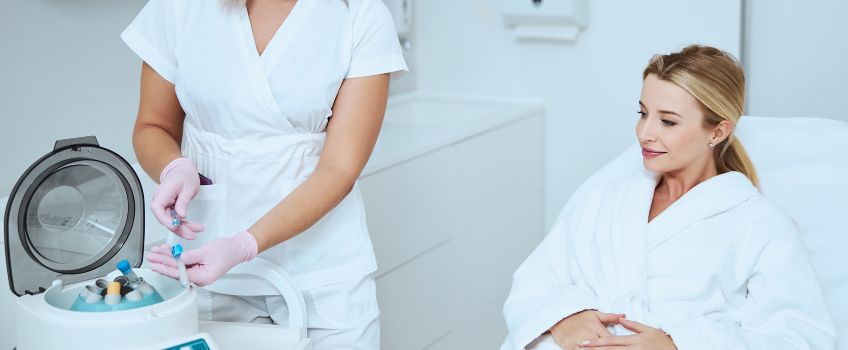
Discover if a single session of PRP Therapy is truly enough for effective hair regrowth.
Platelet-rich plasma (PRP) therapy has become a popular non-surgical treatment option for hair loss, offering a ray of hope for individuals looking to stimulate hair growth and improve hair density and overall hair health. However, the journey to achieving significant results with PRP therapy is not a one-stop process. Understanding why a single session of PRP is likely not enough for those suffering from hair loss requires a deep dive into the mechanics of PRP therapy, the nature of hair growth cycles, individual variability in response to treatment, and the importance of a tailored treatment plan.
Understanding PRP Therapy
PRP therapy involves drawing a small amount of the patient’s blood, processing it to concentrate the platelets, and then injecting this platelet-rich plasma into the scalp. Platelets are components of blood that play a crucial role in healing and tissue regeneration. They release growth factors that can stimulate the hair follicles, potentially leading to increased hair growth and thickness.
The PRP Process: A Closer Look
Step 1: Blood Collection
The procedure begins with the collection of a small quantity of the patient’s blood, typically drawn from the arm, similar to a routine blood test. The amount of blood required is minimal, yet it contains all the elements needed to prepare the platelet-rich plasma.
Step 2: Blood Processing
Once collected, the blood is placed into a centrifuge, a machine that spins at high speed. This process separates the blood into layers based on the density of its components. Red blood cells, being the heaviest, settle at the bottom, while platelet-rich plasma, which is lighter, collects in a separate layer. This plasma is rich in platelets, growth factors, and cytokines, all of which are crucial for tissue regeneration and healing.
Step 3: PRP Injection
The concentrated platelet-rich plasma is then carefully extracted and injected directly into the scalp areas experiencing hair thinning or loss. This targeted approach allows for the delivery of a high concentration of growth factors precisely where they are needed to stimulate hair follicles and promote hair growth.
The Biology of Hair Growth
Hair growth occurs in cycles, including the anagen (growth phase), catagen (transitional phase), and telogen (resting phase). Each hair follicle operates independently, meaning at any given time, different hairs are in different phases of the growth cycle. PRP therapy aims to stimulate hair follicles to enter or prolong the anagen phase, where hair growth is active. However, because hair follicles cycle asynchronously, multiple sessions are required to target more follicles effectively. According to the research conducted by Puig et al. (2016) there was no noticeable difference in the improvement of hair parameters after just one PRP session compared to a placebo.
The researchers proposed that a single session of PRP might not be enough to achieve a significant clinical impact. This hypothesis appears to be supported by findings from Tawfik et al. (2018) and Dubin et al. (2020), who noted that PRP was more effective than placebo when administered over a series of regularly scheduled PRP sessions rather than a single session of PRP.
The Cumulative Effect of PRP Treatments
Research suggests that the benefits of PRP therapy, including increased hair count, thickness, and growth phase duration, are most evident after multiple sessions. A single session of PRP may start the process of stimulating the follicles, but it is the cumulative effect of several treatments that leads to significant improvements. This is because each treatment builds upon the last, enhancing the stimulation of the hair follicles and providing a more sustained release of growth factors over time.
In a series of studies exploring the effectiveness of PRP therapy for Androgenetic Alopecia (AGA), multiple sessions were found necessary for significant results. One study required four sessions at one-month intervals to achieve very good outcomes.
Gkini et al. (2014) conducted research patients with AGA, administering three PRP sessions every three weeks, followed by a booster session after six months. This study reported a substantial increase in hair density at both 3 and 6 months post-treatment, with notable reductions in hair loss.
Similarly, Singhal et al. (2015) observed clinical enhancements in hair count, thickness, root strength, and overall alopecia conditions in 10 patients after PRP treatment every 2–3 weeks over three months, contrasting with no progress in a control group. These findings align with other research indicating that three monthly PRP sessions can effectively treat AGA, supporting the conclusion drawn from our study. A 2021 study found at least four PRP sessions are necessary to see significant results in those who are experiencing hair loss (Yepuri & Venkataram, 2021).
Individual Variability in Response to PRP
Individual responses to PRP therapy can vary widely based on factors like the underlying cause of hair loss, age, health status, and lifestyle. Some individuals may see noticeable improvements after just a few sessions, while others may require more treatments to achieve visible results. This variability underscores the importance of a personalized treatment plan, developed in consultation with our team, in order to determine the optimal number and frequency of PRP sessions for each individual.
Optimizing Treatment Outcomes
For PRP therapy to be most effective, it’s often combined with other hair loss treatments, such as minoxidil, finasteride, or nutritional supplements. Incorporating these adjunct therapies can enhance the effects of PRP, promoting a more robust hair growth response. Furthermore, ongoing maintenance sessions, typically every 6 to 12 months after the initial series of treatments, are recommended to sustain the results achieved. Additionally, a higher number of platelets may yield greater results than a lower number of platelets. Currently, there’s a vast range of PRP produced by various systems on the market.
A detailed analysis of 34 different systems revealed a significant disparity in Platelet Increment Factors (PIF), with a difference of 28 times between the system producing the lowest and the one producing the highest platelet concentrations (Yam, 2022). A 2021 study found PRP preperations with higher platelet counts may offer better outcomes in terms of hair density, follicle diameter, and terminal hair density (Sasaki, 2021).
Setting Realistic Expectations
It’s crucial for individuals considering PRP therapy for hair loss to have realistic expectations. While PRP can be a powerful tool in the fight against hair loss, it is not a cure-all. The effectiveness of PRP therapy varies, and in some cases, it may be used best as part of a comprehensive approach to managing hair loss rather than a standalone solution.
Conclusion
Understanding why one or single session of PRP is not enough for hair loss hinges on grasping the complexities of hair growth, the nature of PRP therapy, and the individual factors that influence treatment outcomes. A single PRP session may lay the groundwork for hair regeneration, but it is through multiple, carefully timed treatments that individuals can achieve the most significant improvements. By approaching PRP therapy with patience, realistic expectations, and a commitment to a tailored treatment plan, individuals can optimize their chances of success in the battle against hair loss.
Ready to explore the transformative potential of Platelet-Rich Plasma (PRP) therapy for your hair loss journey? At LMC – Laser Medical Clinic, we understand that navigating hair restoration options can be overwhelming. That’s why we’re offering a complimentary PRP consultation to help you understand how this innovative, non-surgical treatment can stimulate hair growth and improve hair density tailored to your unique needs.
With PRP therapy, achieving significant hair restoration results goes beyond a single treatment; it’s a carefully planned journey tailored to each individual’s hair growth cycles and specific conditions. Our expert team is dedicated to crafting personalized treatment plans that align with the latest research and your personal hair restoration goals.
Whether you’re just beginning to explore hair loss solutions or seeking to enhance your current regimen, let us guide you through the benefits of PRP therapy, supported by the latest studies and our clinical experience. Discover how a series of PRP sessions, complemented by a maintenance schedule and possibly adjunct therapies, could be the key to unlocking fuller, healthier hair.
Don’t let hair loss hold you back any longer. Contact LMC – Laser Medical Clinic today for your complimentary PRP consult and take the first step towards reclaiming your confidence with a fuller head of hair. Let’s embark on this journey together, with expert guidance and a treatment plan customized just for you.
References
To book your complimentary consultation appointment, call us at 416-548-6548 Book a Consultation
